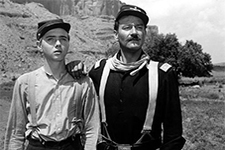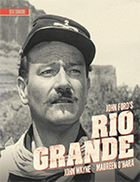Rio Grande
|  John Ford didn’t particularly want to make Rio Grande. Since returning from World War II, where he had made documentaries as the head of the photographic unit for the Office of Strategic Services, he had directed primarily Westerns, including My Darling Clementine (1946), Fort Apache (1948), 3 Godfathers (1948), She Wore a Yellow Ribbon (1949), and Wagon Master (1950). Ford, who had made more than two dozen Westerns before the war, as well, was eager to move onto his dream project, the Irish-set romantic comedy The Quiet Man, but Herbert J. Yates, the head of Republic Pictures, which was financing both films, insisted that Ford make Rio Grande first because he was skeptical about The Quiet Man’s box office potential and wanted the Western as insurance against the losses he assumed he would have to take (the ultimate irony is that The Quiet Man became one of Ford’s biggest hits). Rio Grande, despite being the final part of the loose “Cavalry Trilogy,” which also includes Fort Apache and She Wore a Yellow Ribbon, and the seventh of Ford’s 14 collaboration with John Wayne, is one of his less inspired Westerns, and one can’t help but wonder if he was unduly affected by his desire to make a different film and having this one essentially forced on him. Of course, John Ford is not going to make a bad film, especially at this stage of his career, although much of it feels pro forma, a kind of cinematic going-through-the-motions that results in a quality film that nevertheless lacks the edge, dynamism, and daring of his best works. Wayne stars as Lt. Col. Kirby Yorke, who is leading the 2nd U.S. Cavalry Regiment on the Texas frontier around 1879. His mission is to protect settlers from Apache attacks, but most of the dilemmas with which he deals are domestic, as his regiment is joined by Jefferson “Jeff” Yorke (Claude Jarman Jr., who had won an Oscar in 1947 for “Outstanding Child Actor” for his role in The Yearling), the teenage son he hasn’t seen in 15 years. Soon thereafter arrives Kathleen (Maureen O’Hara), Yorke’s long-estranged wife and Jeff’s mother, who does not approve of their son having joined the military as a trooper (we learn that he failed out of West Point). Kathleen’s arrival allows for the rekindling of the long dormant marital flame, while Jeff’s presence gives Yorke the chance to experience the pride of being a father, although he is resolute in treating his son no differently from the rest of the men. There are subplots involving Jeff’s conflict with another soldier, the lingering resentment Kathleen feels toward Sergeant Major Quincannon (Victor McLaglen) for actions he took during the Civil War under Yorke’s command, and the arrest of Trooper Travis Tyree (Ben Johnson), an older recruit who has been on the run from charges of manslaughter. The domestic issues and dramatic subplots give way in the second act to more conventional action, as the regiment is called in to cross the Rio Grande into Mexico to pursue a group of Apaches who attacked them to release their captive leader. Rio Grande was the first of five films that paired Wayne and O’Hara, and their chemistry is one of the film’s best qualities (they would also headline The Quiet Man to even greater effect). The film gives Wayne some room to work, as he must balance his role as both traditional heroic leader and a failed father and husband looking for redemption. What does not work particularly well is the film’s heavy reliance on diegetic songs, which are intended to be reflective of the camaraderie of the men and the means by which they entertain themselves in the lonely stretches of non-action along the border with impromptu self-created music, but ultimately feels corny and shoehorned, especially as all the songs are performed by The Sons of the Pioneers, a long-running country-and-western group that just happened to be under contract to Republic Pictures (one of co-founding members was Leonard Slye, who was rechristened Roy Rogers when he left the group in 1937 to pursue a solo singing/acting career). Most of the songs were penned by Stan “The Singing Ranger” Jones, whose most famous song, “(Ghost) Riders in the Sky,” had been a huge hit the year before. And, had these songs been performed in any manner that resembled the kind of dust-and-grit realism that Ford favored in his action scenes, they might have made a meaningful contribution to the film’s sense of time and place, instead of feeling like slickly produced sops to the ancillary market. The screenplay was written by James Kevin McGuinness, who had worked on a half-dozen of Ford’s earlier films and also collaborated with him on his wartime documentaries The Battle of Midway (1942) and December 7th (1942). The screenplay was based on the short story “Mission With No Record” by James Warner Bellah, which had originally been published in 1947 in The Saturday Evening Post. Bellah, a consummate pulp Western writer, had already supplied stories for a number of Ford’s recent films, including Fort Apache and She Wore a Yellow Ribbon, and he would go on to co-write with Willis Goldbeck the screenplays for Ford’s Sergeant Rutledge (1960) and The Man Who Shot Liberty Valance (1962). The crew was also populated by Ford regulars, including cinematographer Bert Glennon, who shot nine of Ford’s films, including Stagecoach (1939) and Young Mr. Lincoln (1939), and editor Jack Murray, who assembled 15 of Ford’s films beginning with The Prisoner of Shark Island (1936) and including The Quiet Man (1952) and The Searchers (1956). Yet, despite all that talent behind the camera, Rio Grande still strikes one primarily as a film that Ford just wanted to get done.
Copyright © 2021 James Kendrick Thoughts? E-mail James Kendrick All images copyright © Olive Films | |||||||||||||||||||||||||||||
Overall Rating: 

 (2.5)
(2.5)


